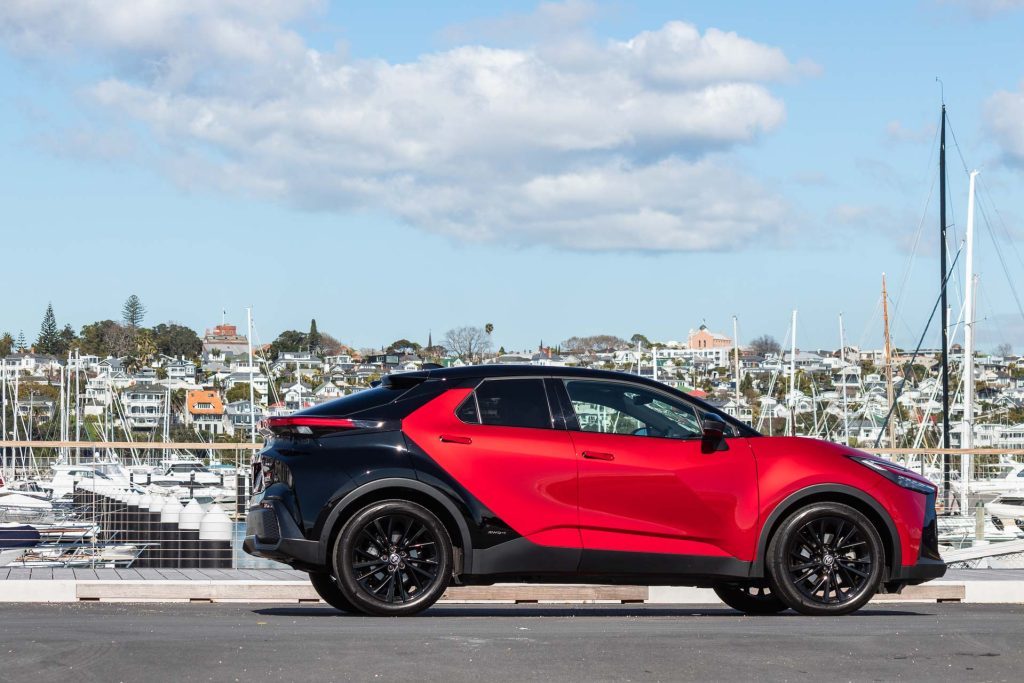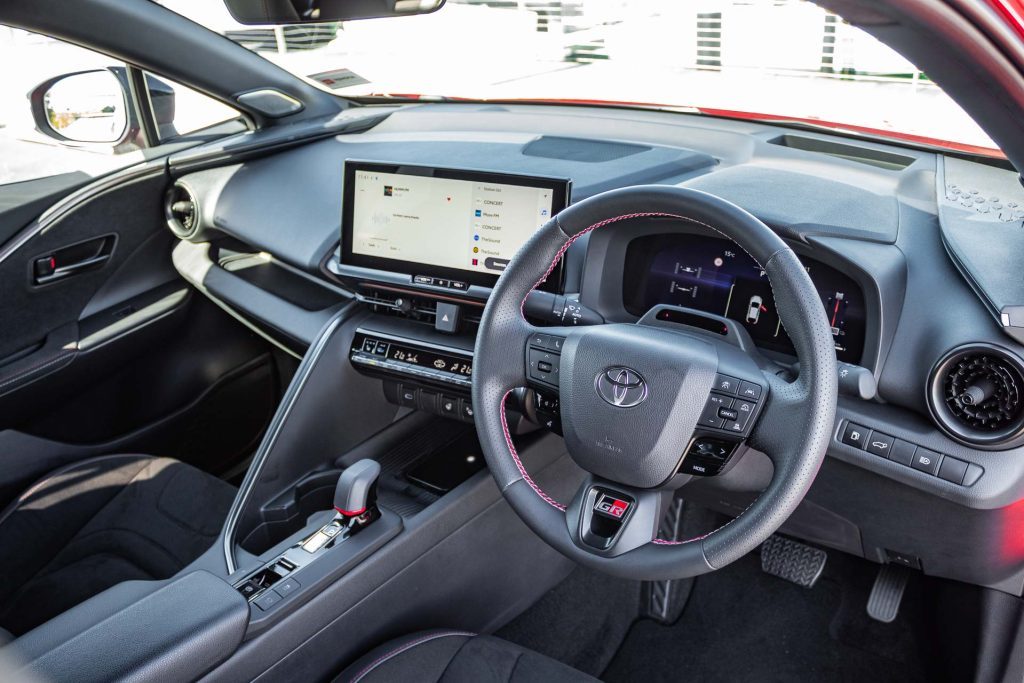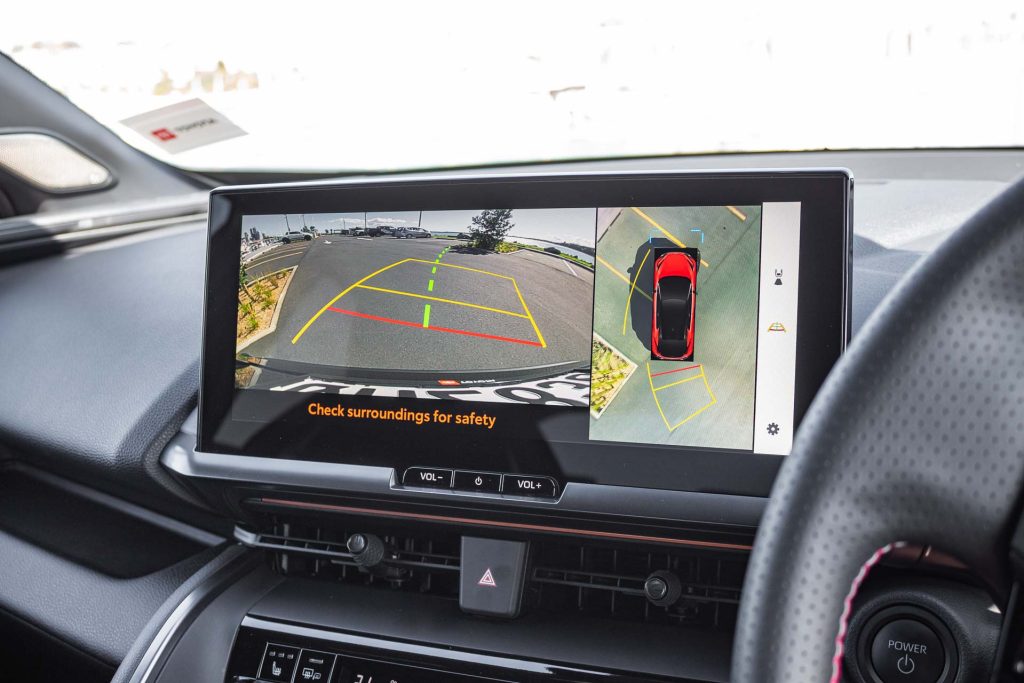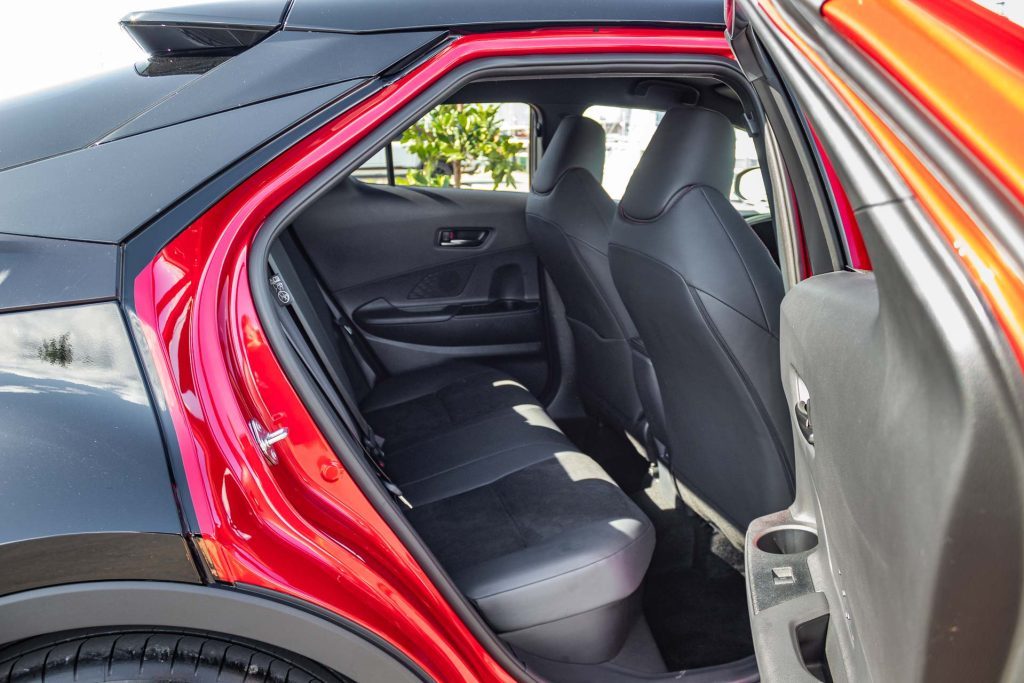After Toyota established its Gazoo Racing brand with little crackers like the GR Yaris and the Toyota GR86, it’s only natural that the marketing department will seize on the opportunity to spread some of that GR goodness to lesser models.
The C-HR GR Sport Hybrid E-Four all-wheel drive with two-tone plus paint, to give this number its full model designation, is best thought of as GR-lite. It has a sprinkling of sportiness, but it’s not a sports model per se.
It does have a few more herbs though. While the regular Toyota C-HR GXL Hybrid runs a 1.8-litre hybrid set-up, this has a hi-po 2.0-litre four making 112kW and 190Nm, besting the 1.8’s 72kW and 142Nm.

The total system output is 145kW, up 42 on the 1.8. That’s due to there being an extra electric motor on the rear that gives this its all-wheel drive status. It’s a bit heavier as a result at 1575kg, 85kg more than the front driver.
Consumption for the GR Sport is said to be 4.5L/100km (104 g/km), and on paper it’s only a point worse than the 1.8 model.
We saw 5.1L/100km over the course of our week with the GR Sport, whereas we registered 4.6L/100km in the front-drive GXL version the week prior.
Oh well, no biggie in the scheme of things. It equates to an extra 75 litres of gas over a typical 15,000km year.
Against the timer, the GR Sport runs to 100 in eight flat, 2.3sec ahead of the front driver, while it’s 2.5sec quicker when it comes time to overtake. So it is certainly more energetic on the highway.

There’s also more urge in general commuting; where the 1.8 C-HR feels merely adequate, this is easier, with better pull. All-wheel drive helps it get off the mark quicker too.
But otherwise, the rear motor lies dormant most of the time, adding its extras when accelerating more vigorously, well, according to the little drive display on the dash anyway.
When you switch the C-HR off, your ‘EV driving ratio’ will flash on the screen, telling you how much of your drive was achieved with the engine off.
And when ambling about town, don’t be surprised to see an EV ratio of at least 50 per cent.
Toyota’s ‘self charging’ hybrid system, now in its fifth generation, is a refined and efficient operator.
Once up to speed, it’ll often switch the engine off, the motor enough to maintain your cruising momentum. And when more go is required, the engine comes in seamlessly to help accelerate.
The suspension is said to have a GR sport tune but don’t worry, it’s not to the detriment of the ride quality, which remains civilised. There’s better control here compared with the 1.8.

Expect a slightly keener attitude from the steering and a sterner resolve from the front end when you send it through a corner. And with extra output and the additional stick of the rear wheels helping out, it drives more convincingly off the bend too.
But sporty? Not quite, just more polished than the front driver. Want small and truly sporty from Toyota in an SUV sort of package? You’ll need to wait for the Lexus LBX Morizo RR, and be prepared to pay a lot more too.
As the top model, the GR has a replete spec fit out. Figure on Bluetooth audio streaming via the 12.3-inch colour touchscreen along with Qi charging and wireless CarPlay and Android Auto, sounding off through the nine-speaker JBL system.
There’s eight-way power adjustment for the both front seats, which are heated and trimmed in pseudo-leather and suede. Sat nav, a surround view camera, head-up display and smart key all feature too.
The C-HR is a striking machine, though not everyone’s cup of tea, it seems. We reckon the spiffy two tone-paint scheme, a $1000 option for Limited and GR Sport buyers, is worthwhile too.
Toyotas now come loaded with safety equipment, most functioning in a helpful rather than frustrating manner. The adaptive cruise control handles traffic well, the lane keeping tolerable.

The ever vigilant driver monitor is quick to deliver an alert should you look away from the road for too long, though it’s of the discreet variety.
The speed recognition system also has a watchful eye on your rate of knots, the prescribed limit highlighted on the dash. And should you find yourself a few clicks over, that speed limit sign will start flashing.
C-HR is of the compact SUV variety and so legroom in the rear is merely adequate, at best. The small side windows and dark headliner don’t help the feeling of spaciousness either.
Its boot is reasonably sized, measuring 422 litres, which is more than the front driver gets as this makes do without a spare wheel.
So there’s a bit more depth to the hold, which can be expanded by dropping the back seats, an easy enough task.
Is the GR worth paying the extra for? If you’re contemplating the Limited, this is only $3k more, and worth it for the added ease the extra output offers.
However, if economy is everything, save the money and look at the C-HR GXL at $49,990.
| Model | Toyota C-HR GR Sport Hybrid E-Four |
| Price | $56,990 |
| Engine | 1998cc, IL4 |
| Power | 112kW@6000rpm |
| Torque | 190Nm@4400rpm |
| Hybrid Output | 145kW |
| Drivetrain | e-CVT, e-AWD |
| Weight (claimed) | 1575kg |
| Fuel Use | 4.5L/100km |
| C02 Output | 104g/km |
| 0-100km/h | 8.0 sec |
This article first appeared in the October 2024 issue of NZ Autocar Magazine.


